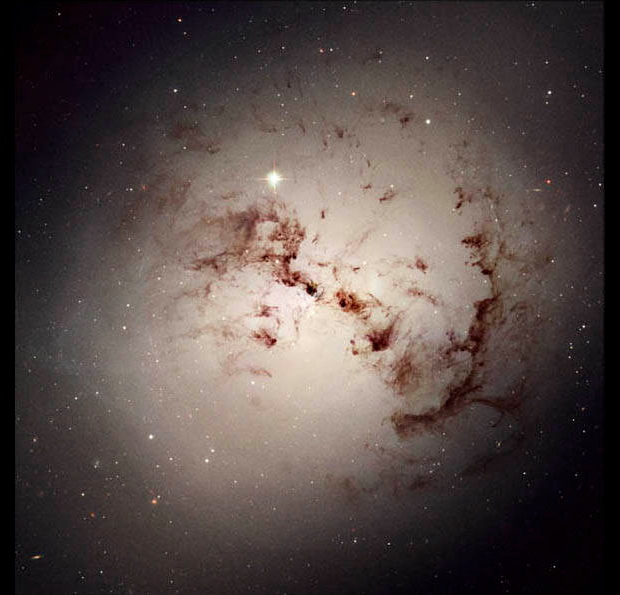What Are Elliptical Galaxies?
Elliptical galaxies are the most abundant type of galaxies found in the universe but because of their age and dim qualities, they're frequently outshone by younger, brighter collections of stars.
Elliptical galaxies lack the swirling arms of their more well-known siblings, spiral galaxies. Instead, they bear the rounded shape of an ellipse, a stretched-out circle.
One of the most famous elliptical galaxies is Cygnus A, which is located roughly 600 million light-years from Earth and is an extremely bright radio source. Cygnus A is not only well-known to astronomers, but has a place in science fiction; it was featured in the 1985 novel "Contact," a Carl Sagan story that later inspired a Hollywood movie of the same name.
Classification and characteristics
In 1926, Edwin Hubble devised a system to classify galaxies. Known as the Hubble sequence, or the "Hubble tuning-fork," it organizes galaxies based on their shape. Under this organization, elliptical galaxies are classified by how stretched out they are. Galaxies classified as E0 appear to be almost perfect circles (remember, a circle is an ellipse), while those listed as E7 seem much longer than they are wide. A galaxy's appearance is related to how it lies on the sky when viewed from Earth. A galaxy having the E7 shape but seen head on would appear as an E0, for instance, because observers would not see its stretched shape, which lies "behind" it.
Elliptical galaxies have a broader range in size than other types of galaxies. The smallest are dwarf elliptical galaxies, which can be less than 10 percent of the size of the Milky Way. But ellipticals can also stretch to more than a million light-years across, and contain more than ten trillion stars. M87, identified as one of the largest galaxies in the universe, is classified as an E0 elliptical galaxy.
Astronomers have identified more spiral galaxies than ellipticals, but that's simply because the spirals are easier to spot. While spiral galaxies are bright, elliptical galaxies are dim. Spiral galaxies are hotbeds of star formation, but elliptical galaxies aren't nearly as prolific because they contain less gas and dust, which means fewer new (and brighter) stars are born. The existing stars inside an elliptical galaxy tend to be older, giving off more red light than younger stars.
So, why do astronomers think elliptical galaxies dominate the sky? Because when specific regions of the sky are studied in depth, more elliptical galaxies appear. Astronomers think such counts are consistent throughout the universe.
Breaking space news, the latest updates on rocket launches, skywatching events and more!
History and formation
Because elliptical galaxies contain older stars and less gas, scientists think that they are nearing the end of the evolutionary line for galaxies. The universe is a violent place, and collisions between galaxies are frequent — indeed, the Milky Way is due to crash into the Andromeda Galaxy in a few billion years. When two spirals collide, they lose their familiar shape, morphing into the less-structured elliptical galaxies.
A supermassive black hole is thought to lie at the center of these ancient galaxies. These gluttonous giants consume gas and dust, and may play a role in the slower growth of elliptical galaxies.
Born from collision, elliptical galaxies are more commonly found around clusters and groups of galaxies. They are less frequently spotted in the early universe, which supports the idea that they evolved from the collisions that came later in the life of a galaxy.
Research in just the past few years has revealed quite a bit about the evolution of elliptical galaxies.
A 2014 study showed that supermassive black holes might be stopping star formation in elliptical galaxies, which would help explain why there are so few new stars in ellipticals. Previously, astronomers thought ellipticals lacked the cold gas necessary for star formation, but the new study showed that there is actually a lot of cold gas in ellipticals, it's just blasted away by supermassive black holes in the region.
In 2015, researchers discovered that some compact ellipticals might lose most of their mass through galaxy interactions, which has large implications for what happens when galaxies merge and collide.
Galaxy mergers with ellipticals could even produce weird hybrids, such as the Sombrero Galaxy. A 2012 examination by NASA's Spitzer Space Telescope found that Sombrero is made up of one galaxy inside of another; the study reclassified Sombrero to an elliptical galaxy with a flat disk inside of it.
Such examinations sometimes also reclassify elliptical galaxies into other types, such as with UGC 1382 in 2016. Scientists determined that the galaxy was not an elliptical, but a sort of strange combination of cosmic pieces that came about through various mergers. Scientists are now interested in how many other similar galaxies reside in our universe.
Further reading:
- Read more about galaxies, from NASA's Imagine the Universe.
- Read the definition of elliptical galaxies according to Swinburne University of Technology.
- Examples of elliptical galaxies from the Sloan Digital Sky Survey.

Elizabeth Howell (she/her), Ph.D., was a staff writer in the spaceflight channel between 2022 and 2024 specializing in Canadian space news. She was contributing writer for Space.com for 10 years from 2012 to 2024. Elizabeth's reporting includes multiple exclusives with the White House, leading world coverage about a lost-and-found space tomato on the International Space Station, witnessing five human spaceflight launches on two continents, flying parabolic, working inside a spacesuit, and participating in a simulated Mars mission. Her latest book, "Why Am I Taller?" (ECW Press, 2022) is co-written with astronaut Dave Williams.

